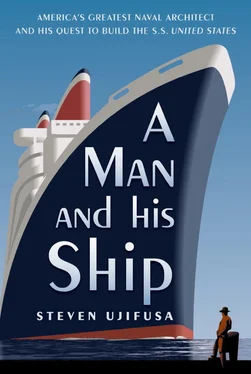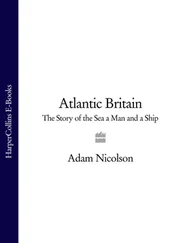In June 1910, William Francis Gibbs’s original college class graduated. A Harvard dean reminded Gibbs that he still hadn’t fulfilled his German requirement. He never did, and he later claimed he left Harvard because he flunked Latin. Most likely he dropped out because his father could no longer afford the cost of tuition and his fancy room in Claverly Hall.
The Gibbs family’s losses were confirmed on December 2, 1910, when the Philadelphia’s sheriff office seized 1733 Walnut Street and transferred it to the holders of the first mortgage of nearly $180,000—over $4 million today. The couple also defaulted on the second mortgage of $60,000 put up by friends. 22The vaunted $15 million that the Gibbs family had once been said to possess had vanished. None of their rich friends seems to have come to their aid.
Sometime earlier that year, William Warren had pulled his oldest son aside for a talk. A humiliated father wanted to make sure that his son would become a respectable lawyer who would earn the steady, good salary needed to support his family. An unhappy son made a deal with his father. He would finish his undergraduate degree at Columbia and then attend its law school. To pay for both, he would work at the same time. He then agreed to practice law for a year and send money home. After a year, his father told him sternly, he could do what he wanted. 23
During the years Gibbs spent at Columbia, 1910 to 1913, the former Gibbs mansion at 1733 Walnut Street sat vacant. Its windows, through which passersby could once see light streaming from crystal chandeliers, now showed nothing inside but a dark, skull-like emptiness. The abandoned house was finally sold to a developer, who wanted to build a luxury apartment building on the site. 24The wreckers hacked away at the brick walls, tore out paneling, and broke up a fountain in the reception room, which according to a newspaper report had once “delighted all beholders with the beautiful effects produced by the water flowing over a bewildering number of incandescent bulbs.” 25
Twenty-six-year-old William Francis Gibbs did not appear to have looked back. He graduated from law school and went to work in a small New York firm that specialized in real estate law. Each month, he sent money home to support his father and the rest of the family: mother Frances, brother Frederic—who because of the family’s financial ruin would never attend college—and two unmarried sisters, Bertha and Genevieve. But even as he served as the dutiful son, he was looking for a way to get out of being a lawyer before his promised year was up.
“My father was an entrepreneur,” Gibbs confided to a friend many years later. “You know what that means? He wanted me to get into a solid profession—the law. He thought engineering was pretty unstable—said most of the engineers he knew were pretty impractical people.” His friend noticed that Gibbs’s voice hardened with belligerence as he remembered his father. But the son also conceded that he would never have amounted to anything if his father hadn’t gone bankrupt and forced him to work for a living. 26Gibbs also realized that in order to make something of himself, he would have to be a fighter. “Learn to withstand body blows because it’s the man who’s standing at the end of the fight that wins,” he said. 27
In time, William Francis Gibbs would demonstrate a business savvy beyond that of his promoter father. But despite his intense drive, he strove to remain scrupulously honest, and he turned a blind eye toward social acceptance for its own sake. Wealth and appearances, he learned, could be fleeting.
While the Gibbs family fortunes sank, the greatest disaster in the history of the North Atlantic blighted the reputation of America’s most powerful financier, as error and arrogance claimed the finest ship in the world.

4. J. P. Morgan’S TITANIC
The nation quickly rebounded from the financial panic, but was captivated by more gripping headlines only a few years later. A tragedy at sea showed that even the greatest ships, built by the most ambitious men, were not as invincible as the public assumed. The Titanic disaster would always haunt William Francis Gibbs, as well as the man who would one day become one of his dream ship’s biggest financial backers.
As darkness fell over New York on the evening of April 15, 1912, a tall, solemn-faced twenty-one-year-old Harvard sophomore named Vincent Astor pushed his way through the crowd outside the offices of the White Star Line, the shipping company owned by the International Mercantile Marine and operated by Clement Griscom and J. P. Morgan. Astor had heard rumors in Cambridge that made him drop everything and take the first train to New York.
The airwaves of the North Atlantic were abuzz: the largest, most luxurious ship in the world had struck an iceberg the previous night. But White Star Line management assured the public that their brand-new flagship, although crippled, was still afloat. Yet as more wireless messages streamed ashore, it appeared that the unthinkable had occurred.
Vincent Astor was the son of Colonel John Jacob Astor IV, reputed to be worth $80 million. He was also the grandson of Caroline Schermerhorn Astor, the imperious, diamond-encrusted hostess at the center of New York’s “Four Hundred,” a group of families she deemed acceptable in society. Back even further was the first John Jacob Astor, a barely literate German immigrant who had become the nation’s first millionaire by making shrewd investments in Manhattan real estate. By 1912, in addition to owning the magnificent Waldorf-Astoria hotel, the Astors were also the biggest slumlords in New York City, owners of tenement apartment houses derisively known as “Astor Flats.” 1
Vincent Astor loved automobiles and airplanes more than fancy living, and found his grandmother’s Fifth Avenue chateau a miserable place. 2His father was an aloof, eccentric philanderer who, according to one report, “would set upon him with a shoe or strap.” 3His mother, Ava, verbally abused young Vincent. After spending most of his adolescence at boarding school and tinkering with motorcycles, Vincent had hoped to go to the U.S. Naval Academy. But his father sent him to Harvard instead. There, in his freshman year, Vincent had to endure a scandal that would have unseated most other families from good society: his forty-seven-year-old father divorced his mother and quickly married a nineteen-year-old named Madeleine Force. The Four Hundred was shocked, and the public could not get enough of it. Readers of the tabloids learned that John Jacob Astor IV and his wife, Madeleine, would honeymoon in Europe. They would return on the magnificent new flagship of the White Star Line: the Royal Mail Steamer Titanic.
Once inside the White Star building, Vincent Astor went straight to the office of IMM vice president Philip Franklin. He came out in tears. Vincent’s father was presumed dead, while his pregnant young bride had survived. Gathering himself together, Vincent went to his father’s office and donated ten thousand dollars to help destitute survivors. 4
Titanic was born out of the blood feud between IMM and its German and British competitors. In 1907, the year Cunard’s Mauretania and Lusitania made their maiden voyages, IMM founders J. P. Morgan and Clement Griscom teamed up with White Star president J. Bruce Ismay and Harland & Wolff shipyard president Lord Pirrie to push back. The three dreamed up a trio of three superliners that would be far bigger, more beautiful, and luxurious than anything afloat.
Читать дальше













